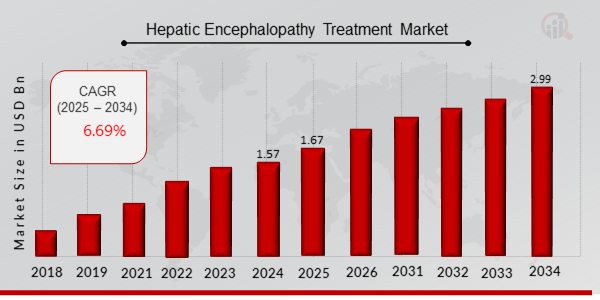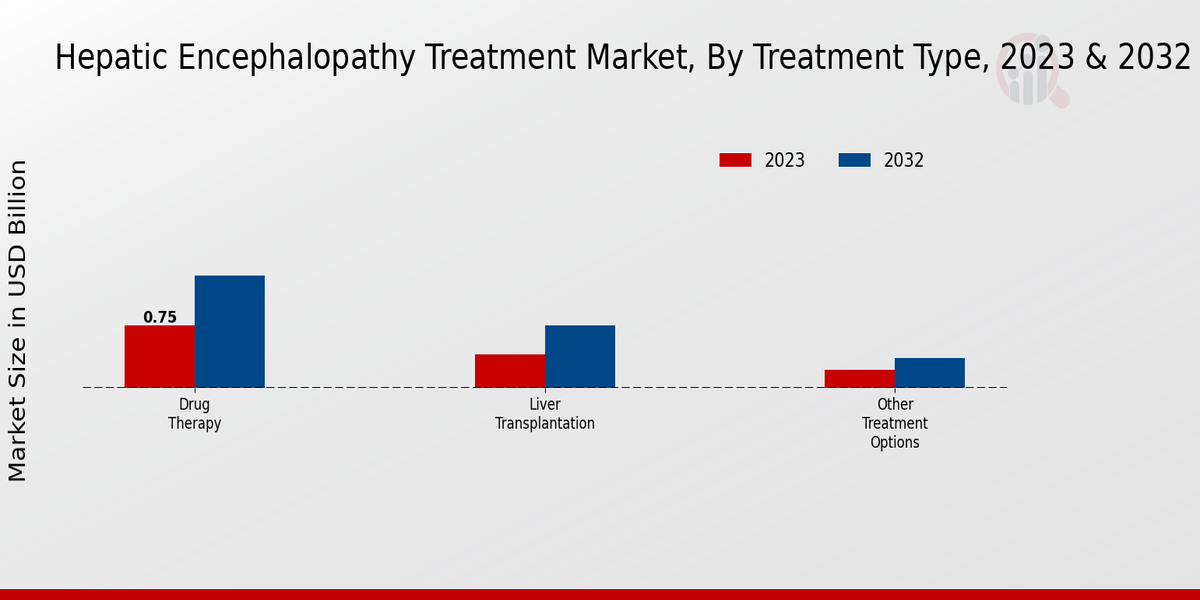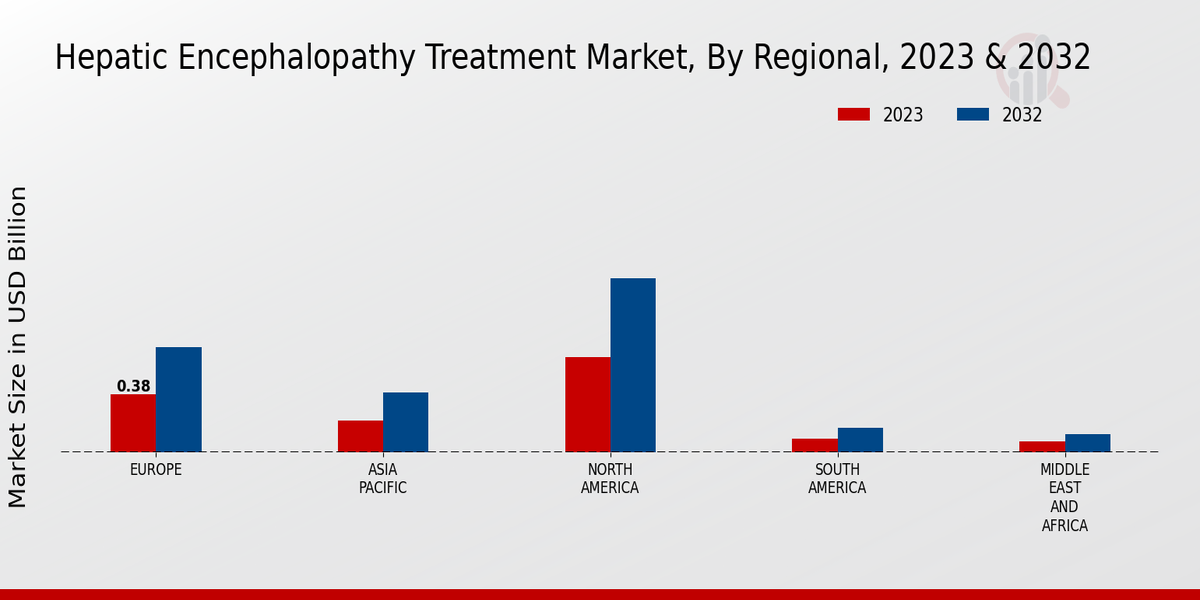Hepatic Encephalopathy Treatment Market Overview
As per MRFR analysis, the Hepatic Encephalopathy Treatment Market Size was estimated at 1.57 (USD Billion) in 2024. The Hepatic Encephalopathy Treatment Market Industry is expected to grow from 1.67 (USD Billion) in 2025 to 2.99 (USD Billion) till 2034, at a CAGR (growth rate) is expected to be around 6.69% during the forecast period (2025 - 2034).
Key Hepatic Encephalopathy Treatment Market Trends Highlighted
The Hepatic Encephalopathy Treatment Market is poised for substantial growth, driven by the increasing prevalence of liver diseases and the rising demand for effective treatments. The market is witnessing key trends such as the development of novel therapies, technological advancements in drug delivery systems, and a growing focus on personalized medicine.
Opportunities abound for players to explore innovative treatment modalities, such as gene therapy and stem cell-based therapies.
Additionally, the adoption of artificial intelligence and machine learning in drug discovery and patient management is expected to create new avenues for market growth. Recent trends have highlighted the importance of early diagnosis and intervention to improve patient outcomes.
Pharmaceutical companies are actively engaged in research and development to address the unmet medical needs in hepatic encephalopathy treatment. The approval of new drug therapies, coupled with the growing awareness about the condition, is anticipated to drive market expansion over the forecast period.

Source: Primary Research, Secondary Research, MRFR Database and Analyst Review
Hepatic Encephalopathy Treatment Market Drivers
Rising Prevalence of Liver Diseases
The rising prevalence of liver diseases, such as cirrhosis and non-alcoholic fatty liver disease (NAFLD), is a major driver of the Hepatic Encephalopathy Treatment Market. Cirrhosis, a condition characterized by the scarring of the liver, is a leading cause of hepatic encephalopathy.
NAFLD, a condition in which fat accumulates in the liver, is also a significant risk factor for hepatic encephalopathy. The increasing prevalence of these liver diseases is expected to drive demand for hepatic encephalopathy treatments. According to the World Health Organization (WHO), liver cirrhosis is the 11th leading cause of death worldwide, with an estimated 1.3 million deaths in 2019.
NAFLD is also a growing health concern, affecting an estimated 25% of the global population. The rising prevalence of these liver diseases highlights the need for effective treatments for hepatic encephalopathy, a serious complication of these conditions.
The Hepatic Encephalopathy Treatment Market is expected to benefit from the increasing focus on developing new and innovative therapies for liver diseases. Pharmaceutical companies are investing heavily in research and development to identify new treatment modalities that can effectively manage hepatic encephalopathy and improve patient outcomes.
The development of novel therapies, such as ammonia scavengers, neuroprotective agents, and gene therapies, is expected to drive market growth in the coming years.
Growing Awareness and Diagnosis Rates
Growing awareness of hepatic encephalopathy and increasing diagnosis rates are driving the Hepatic Encephalopathy Treatment Market. In the past, hepatic encephalopathy was undiagnosed or misdiagnosed frequently, leading to delays in treatment and poor patient outcomes.
However, increased awareness of the signs and symptoms of the condition and improvements in diagnostic methods have made it possible to diagnose hepatic encephalopathy earlier and manage it more effectively. Patient and healthcare organizations have made significant efforts to raise awareness about hepatic encephalopathy through various education campaigns and initiatives.
As a result, healthcare professionals and members of the public are better educated regarding the signs and symptoms of the condition, which enables them to diagnose it earlier.
The development of new diagnostic methods, such as blood tests and neuroimaging techniques, further facilitates improving the speed and accuracy of the diagnosis of hepatic encephalopathy. Growing rates of hepatic encephalopathy diagnosis are expected to contribute to the increasing demand for treatment options associated with the condition.
More patients will be diagnosed with the condition, creating demand for effective therapies that could help patients to better manage their symptoms and improve their quality of life.
For this reason, the growing awareness of the condition and the simultaneous improvements in the rate of its diagnosis are expected to contribute to the growth of the Hepatic Encephalopathy Treatment Market in the coming years.
Technological Advancements and New Therapies
Technological advancements and the arrival of new therapies are changing the treatment milieu of hepatic encephalopathy, revolutionizing the markets for the problem. The growing spread of new forms of medication, including ammonia scavengers, neuroprotective therapies, and gene therapies, is one of the key drivers for market growth in the upcoming years.
Ammonia scavengers, such as lactulose and rifaximin, have been the most common form of hepatic encephalopathy medication for many years.
However, new treatment paradigms seek to employ technologies that are more efficient and target-specific. A new group of medications, neuroprotective agents, aims to develop efficient hepatic encephalopathy treatment by protecting brain cells from damage by ammonia.
Gene therapies, which involve the manipulation of the cellular genetic material to prevent disease, are also being investigated as a new therapy for hepatic encephalopathy. The emergence of new therapies and the development of technologies are also an important driver of market growth.
The solutions are expected to achieve better patient outcomes, reduce the suffering of the people, and foster the growth of the Hepatic Encephalopathy Treatment Market in the foreseeable future.
Hepatic Encephalopathy Treatment Market Segment Insights:
Hepatic Encephalopathy Treatment Market Treatment Type Insights
The Hepatic Encephalopathy Treatment Market exhibits a diverse array of Treatment Type options crucial for addressing this serious condition.
Within this scope, Drug Therapy emerged as a dominant segment with a significant market revenue of 0.75 USD Billion, reflecting its essential role in managing the symptoms of hepatic encephalopathy through pharmaceutical interventions. This segment is projected to grow to 1.35 USD Billion by 2032, indicating its importance as the treatment of choice for many patients.
Drug Therapy's widespread adoption was primarily driven by the increasing incidence of liver diseases and the evolving understanding of hepatic encephalopathy management among healthcare providers, making this segment a cornerstone of the treatment landscape.
On the other hand, Liver Transplantation held a noteworthy position, contributing 0.4 USD Billion to the market in 2023. This segment was critical, especially in cases where other treatments are less effective.
The expected growth to 0.75 USD Billion by 2032 underscores the continued reliance on surgical interventions for advanced hepatic encephalopathy, particularly among patients with end-stage liver disease. Although this treatment option is complex and is often limited by donor organ availability, its significance in providing long-term solutions makes it indispensable in the overall market.
Lastly, Other Treatment Options, while valued at 0.22 USD Billion in 2023, are projected to experience growth to 0.36 USD Billion by 2032. This segment encompassed various alternative and supportive therapies, which are gaining traction as complementary options to mainstream treatments.
Although it holds the smallest share, the increasing recognition of holistic approaches to patient care highlights the segment's potential for growth.
The presence of these diverse Treatment Types in the Hepatic Encephalopathy Treatment Market illustrated a well-rounded approach to tackling this complex condition, enabling healthcare providers to tailor treatments based on patient-specific needs.
The market dynamics surrounding these treatment types present numerous opportunities for innovation and expansion, driven by ongoing research and the rising prevalence of liver-related disorders worldwide.

Source: Primary Research, Secondary Research, MRFR Database and Analyst Review
Hepatic Encephalopathy Treatment Market Drug Class Insights
The Drug Class segment plays a critical role in this expansion, prominently featuring Lactulose and Rifaximin, both of which are essential for managing hepatic encephalopathy due to their effectiveness in reducing ammonia levels in patients. Lactulose, a laxative, not only aids in ammonia clearance but also supports gut health, making it indispensable in treatment plans.
Rifaximin, on the other hand, is an antibiotic that helps to alter gut flora, significantly contributing to symptom control and enhancing quality of life. This segment further includes Antibiotics and other compounds that, while perhaps less dominant, complement the primary therapies by targeting different aspects of hepatic dysfunction.
The increasing prevalence of liver diseases globally is driving the need for effective therapies, creating significant opportunities for market growth. Nevertheless, challenges such as high treatment costs and varying patient response rates can impact market dynamics.
As an emerging industry, the Hepatic Encephalopathy Treatment Market shows promising trends with various growth drivers, leading to a rich landscape for stakeholders.
Hepatic Encephalopathy Treatment Market Disease Severity Insights
The Hepatic Encephalopathy Treatment Market showcases a structured segmentation based on Disease Severity, which plays a crucial role in forming treatment strategies. The market is categorized into Mild, Moderate, and Severe Hepatic Encephalopathy, with each category presenting unique treatment challenges and opportunities.
Mild Hepatic Encephalopathy often receives significant focus due to its relatively high prevalence and potential for progression if untreated, while Moderate Hepatic Encephalopathy is recognized for higher healthcare costs, necessitating effective management strategies.
Severe Hepatic Encephalopathy is critical as it involves acute deterioration that can lead to hospitalization, making it a dominant factor in treatment planning and resource allocation. The insights into this segmentation reveal that addressing the variations in treatment response across these categories is vital for optimizing patient outcomes and healthcare resource utilization.
The market growth is influenced by an increasing prevalence of liver diseases, advancement in therapeutics, and rising awareness among healthcare professionals regarding timely diagnoses, offering immense opportunities for stakeholders in the Hepatic Encephalopathy Treatment Market
Hepatic Encephalopathy Treatment Market Patient Age Group Insights
The Hepatic Encephalopathy Treatment Market has shown significant growth, particularly when considering the Patient Age Group dynamics.
The segment is primarily divided into Pediatric and Adult age groups, with adults representing the majority due to the higher incidence of liver diseases that predispose this population to hepatic encephalopathy. The Adult group is vital for market expansion as rising awareness and advancements in treatment options cater to diverse patient needs.
The Pediatric segment, while smaller in comparison, is crucial as it addresses the unique treatment requirements and specific health challenges faced by children with liver disorders. Growth drivers such as increasing prevalence of liver diseases and advancements in healthcare infrastructure are expected to enhance the Hepatic Encephalopathy Treatment Market revenue.
Additionally, the market faces challenges like high treatment costs and the need for specialized healthcare providers. However, the focus on research and development for innovative therapies provides substantial opportunities for growth, influencing Hepatic Encephalopathy Treatment Market statistics positively.
Hepatic Encephalopathy Treatment Market Etiology Insights
Within this market, the Etiology segment plays a vital role, encompassing various underlying conditions leading to hepatic encephalopathy, including Cirrhosis, Hepatitis, Alcohol use disorder, and others. Among these, Cirrhosis emerges as a major concern, contributing significantly to the prevalence of hepatic encephalopathy and leading to an increased demand for effective treatment options.
Hepatitis also holds a substantial portion of the market due to its chronic nature and potential progression to liver failure, while Alcohol use disorder remains a critical area owing to the public health challenge it poses.
Each of these conditions necessitates targeted therapeutic approaches, driving investments in research and development to address the unmet needs in the Hepatic Encephalopathy Treatment Market. Overall, the market demonstrates promising growth trends, driven by rising incidences of liver diseases and increasing awareness of early diagnosis and treatment options.
Furthermore, as healthcare providers continue to prioritize effective management strategies for hepatic encephalopathy, the data surrounding the market continues to evolve, providing opportunities for advancements in treatment protocols and patient care.
Hepatic Encephalopathy Treatment Market Regional Insights
The Hepatic Encephalopathy Treatment Market exhibited significant regional differentiation, with North America leading the market as it accounted for 0.62 USD Billion in 2023, projected to rise to 1.14 USD Billion by 2032. This region's dominance stemmed from advanced healthcare infrastructure and the rising prevalence of liver disorders.
Europe followed, valued at 0.38 USD Billion in 2023 and expected to reach 0.69 USD Billion by 2032, showcasing a growing demand for innovative treatment options. In South America, the market was valued at 0.09 USD Billion in 2023 and is anticipated to grow to 0.16 USD Billion by 2032, reflecting an increasing awareness and improving healthcare access.
The Asia Pacific region, valued at 0.21 USD Billion, is expected to see growth culminating at 0.39 USD Billion by 2032, driven by a high population density and a rising incidence of hepatic diseases. The Middle East and Africa represented a smaller segment, valued at 0.07 USD Billion in 2023, with a slight increase to 0.12 USD Billion by 2032, primarily due to varied healthcare systems and limited disease awareness.
Overall, the regional insights highlight the disparities in market penetration and the unique growth drivers influencing the Hepatic Encephalopathy Treatment Market revenue across different geographies.

Source: Primary Research, Secondary Research, MRFR Database and Analyst Review
Hepatic Encephalopathy Treatment Market Key Players And Competitive Insights:
Major players in the Hepatic Encephalopathy Treatment Market are constantly striving to gain a competitive edge over their rivals. Leading Hepatic Encephalopathy Treatment Market players are investing heavily in research and development activities to introduce innovative products and technologies that cater to the evolving needs of patients.
Strategic collaborations and partnerships with other healthcare organizations are also becoming increasingly common as companies seek to expand their market reach and gain access to new technologies.
The Hepatic Encephalopathy Treatment Market is characterized by intense competition, with several key players vying for market share. These players are continuously developing new strategies to enhance their market position, such as product launches, strategic alliances, and geographical expansion.
Leading pharmaceutical company Baxter International Inc. holds a significant presence in the Hepatic Encephalopathy Treatment Market. The company offers a range of products and services for the treatment of hepatic encephalopathy, including its flagship product, Baxter's EVEXIA Dialysis System.
Baxter International Inc. has a strong global distribution network and a dedicated sales force that enables it to reach a wide customer base. The company's commitment to innovation and its focus on patient care have contributed to its success in the Hepatic Encephalopathy Treatment Market.
Fresenius Medical Care AG & Co. KGaA is another key player in the Hepatic Encephalopathy Treatment Market. The company provides a comprehensive portfolio of products and services for the treatment of chronic kidney disease, including dialysis and filtration systems.
Fresenius Medical Care AG & Co. KGaA has a global presence and a strong focus on research and development. The company's commitment to providing high-quality products and services has earned it a strong reputation in the Hepatic Encephalopathy Treatment Market.
Key Companies in the Hepatic Encephalopathy Treatment Market Include:
- Alfasigma
- Gilead
- Novartis
- Merck Co
- Intercept
- Bristol-Myers Squibb
- Pfizer
- Roche
- Sanofi
- Allergan
- AstraZeneca
- Johnson Johnson
Hepatic Encephalopathy Treatment Market Developments
The growth of the market is attributed to the rising prevalence of liver diseases, increasing awareness of hepatic encephalopathy, and the development of new and effective treatments. Recent news developments in the market include the approval of new drugs for the treatment of hepatic encephalopathy, such as rifampin and lactulose.
Additionally, there is a growing focus on the development of non-invasive and personalized treatment approaches for hepatic encephalopathy, which is expected to further drive market growth in the coming years.
Hepatic Encephalopathy Treatment Market Segmentation Insights
- Hepatic Encephalopathy Treatment Market Treatment Type Outlook
- Drug Therapy
- Liver Transplantation
- Other Treatment Options
- Hepatic Encephalopathy Treatment Market Drug Class Outlook
- Lactulose
- Rifaximin
- Antibiotics
- Others
- Hepatic Encephalopathy Treatment Market Disease Severity Outlook
- Mild Hepatic Encephalopathy
- Moderate Hepatic Encephalopathy
- Severe Hepatic Encephalopathy
- Hepatic Encephalopathy Treatment Market Patient Age Group Outlook
- Hepatic Encephalopathy Treatment Market Etiology Outlook
- Cirrhosis
- Hepatitis
- Alcohol use disorder
- Other
| Report Attribute/Metric |
Details |
|
Market Size 2024
|
1.57 (USD Billion)
|
|
Market Size 2025
|
1.67 (USD Billion)
|
|
Market Size 2034
|
2.99 (USD Billion)
|
|
Compound Annual Growth Rate (CAGR)
|
6.69 % (2025 - 2034)
|
|
Report Coverage
|
Revenue Forecast, Competitive Landscape, Growth Factors, and Trends
|
|
Base Year
|
2024
|
|
Market Forecast Period
|
2025 - 2034
|
|
Historical Data
|
2020 - 2024
|
| Market Forecast Units |
USD Billion |
| Key Companies Profiled |
Alfasigma, Gilead, Novartis, Merck Co, Intercept, Bristol-Myers Squibb, Pfizer, Roche, Sanofi, Allergan, AstraZeneca, Johnson Johnson |
| Segments Covered |
Treatment Type, Drug Class, Disease Severity, Patient Age Group, Etiology, Regional |
| Key Market Opportunities |
Increasing disease prevalence unmet medical needs technological advancements, research and development, and favorable reimbursement policies |
| Key Market Dynamics |
Increased disease prevalence Advancements in treatment Growing geriatric population Government initiatives Rise in RampD activities |
| Countries Covered |
North America, Europe, APAC, South America, MEA |
Frequently Asked Questions (FAQ) :
The Hepatic Encephalopathy Treatment Market is expected to be valued at 2.99 USD Billion by 2034.
The expected CAGR for the Hepatic Encephalopathy Treatment Market from 2025 to 2034 is 6.69%.
North America is anticipated to have the largest market share, valued at 1.14 USD Billion in 2032.
The market size for Drug Therapy is expected to reach 1.35 USD Billion by 2032.
Major players in the market include Alfasigma, Gilead, Novartis, Merck Co., and Bristol-Myers Squibb.
The market value for Liver Transplantation was 0.4 USD Billion in 2023.
The market size for the South American region is projected to grow to 0.16 USD Billion by 2032.
The expected market value for Other Treatment Options is projected to be 0.36 USD Billion by 2032.
The market value for the Asia Pacific region was 0.21 USD Billion in 2023.
Key growth drivers include advancements in treatment options, increasing prevalence of liver disease, and rising healthcare expenditure.

















